I usually spend at least a week discovering potential high-yield projects; this period is when I test the project, and if it hasn’t been passed, I start writing in-depth articles, so the entire content cycle generally takes 1-2 weeks.
The benefit of this is that many of the projects I share eventually become significant, like Ethena, ListaDao, Blue, Walrus, Hyper, Particle, Grass...
In early July, I noticed Pendle launched a new pool called Terminal, and in just two weeks, its TVL surged from $0 to $140M. At that time, I saw Ethena and EtherFi were providing incentives for this project, which intuitively told me that the project's background must be strong, and the chance of making significant profits was quite high. So I spent two weeks understanding the gameplay and narrative of Terminal, and today I am sharing it for reference.
This article mainly includes the following content:
Overview of Terminal airdrops
Completely understand Pendle-Terminal's core gameplay
How to maximize returns from Terminal
Why Terminal is considered a high-potential project (technical analysis)
1. Overview of Terminal airdrops
Terminal Finance is a DeFi platform providing yield trading for institutions, where early users can earn corresponding rewards through its token incentive program called 'Roots'.
Users on the Pendle platform use supported assets (like tUSDe, tETH, tBTC) to mine Terminal, which yields higher returns than simply holding points. The more Roots points accumulated, the higher the future returns, and the Roots points can eventually be exchanged for the official token $TML.
Since the Converge chain does not have a native token, $TML will be the first native token on Converge with strong potential.
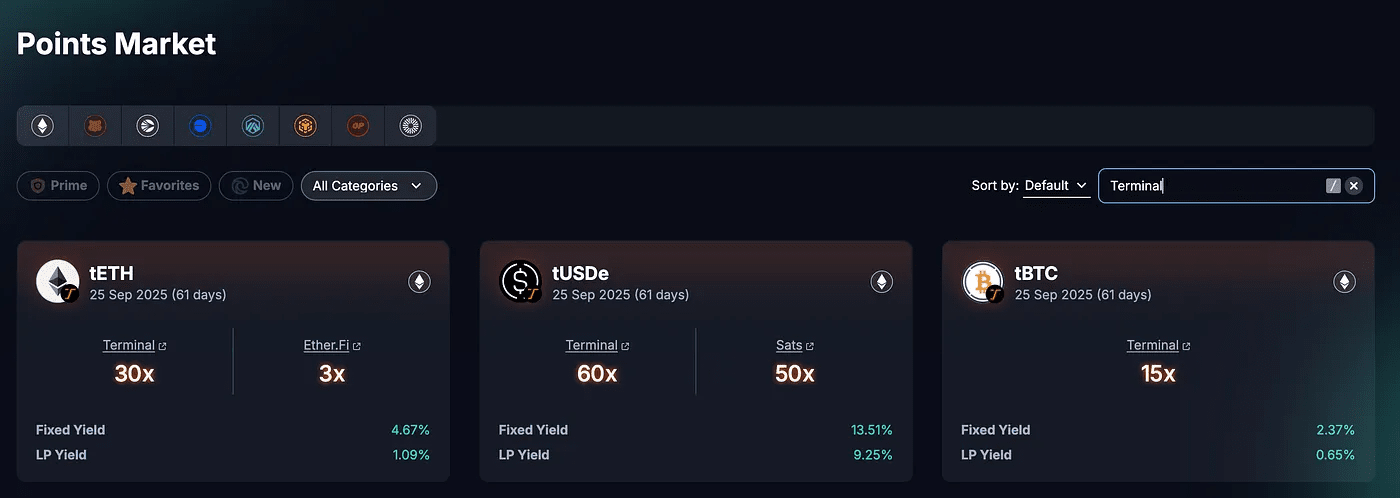
Related link: https://app.pendle.finance/trade/points?search=Terminal
The rewards for the three pools provided by Terminal are different, details are as follows:
(1) tETH pool
YT: Earn 30x Roots points + 3x Ether.Fi points + floating annual yield;
PT: 4.67% fixed annual interest rate;
LP: PT's fixed income + trading fee income + PENDLE incentives + Roots points provided by the non-PT portion;
(2) tUSDe pool (highest points reward)
YT: Earn 60x Roots points + 50x Sats points + floating annual yield;
PT: 13.51% fixed annual interest rate;
LP: PT's fixed income + trading fee income + PENDLE incentives + Roots points provided by the non-PT portion;
(3) tBTC
YT: Earn 15x Roots points + floating annual yield;
PT: 2.37% fixed annual interest rate;
LP: PT's fixed income + trading fee income + PENDLE incentives + Roots points provided by the non-PT portion;
The above 60x points are an incentive for early users after the collaboration between Terminal and Ethena, and will not remain this high in the future, so early participation leads to early profits.
Participation link: https://app.pendle.finance/trade/points/0x07b1711d4af74af661dde3b774741993b79fc59c?chain=ethereum&search=Terminal
It should be noted: simultaneously buying YT and PT does not provide any rewards; inviting others without participating yourself also does not earn any rewards.
2. Completely understand Pendle's gameplay (experienced users can skip)
Pendle represents DeFi 3.0, but aside from those specifically engaged in DeFi, many people cannot clearly explain Pendle's strategies, leading many readers to see high-potential projects on Pendle without knowing how to achieve high yields.
Today we will clarify Pendle's gameplay to facilitate the next practical operation of 'maximizing Terminal returns'.
In simple terms, Pendle has four core concepts: SY (Standardized Yield Asset), PT (Principal Token), YT (Yield Token), LP (Liquidity Provider Position), as shown in the relationship diagram below:
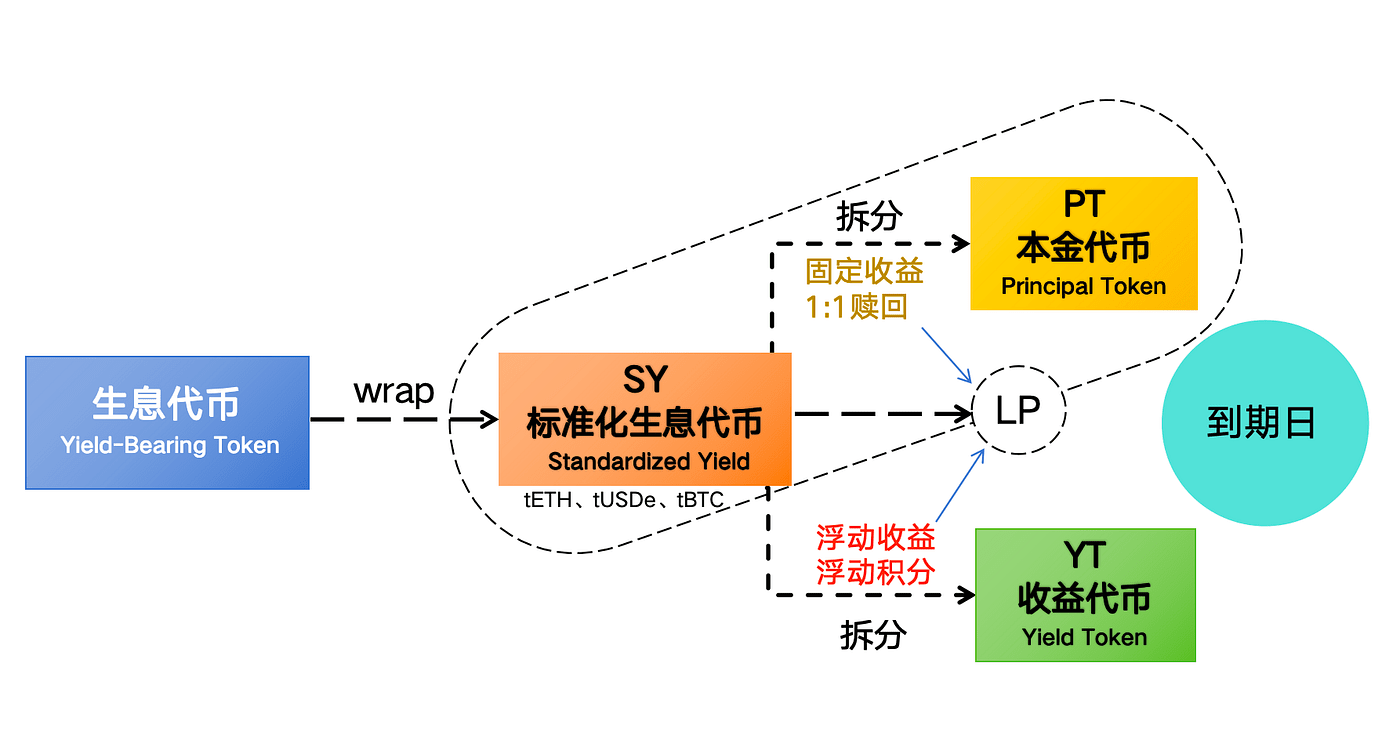
How to understand the above relationship?
(1) First understand: Yield-Bearing Token
Yield-bearing tokens need to be understood in conjunction with token assets; common assets like BTC, ETH, BNB, SOL are token assets, and they do not participate in DeFi and only have collectible and trading value; even in ordinary DeFi, they generally only serve as standard assets for single yields.
After LSD appeared, the concept of yield-bearing tokens has firmly established itself in DeFi. The gameplay is: deposit BTC, ETH, BNB, SOL into the LSD platform, and the LSD platform will generate a token certificate, such as SolvBTC, stETH, slisBNB, etc. Ordinary assets with an xx prefix can be considered yield-bearing assets, meaning they have gone through the LSD platform and can earn interest from it.
(2) Standardized Yield Token (SY)
Simply put, this is [packaged 'yield-bearing assets'], all assets entering Pendle first become SY, making it easier for Pendle to split later. Any pool names you see in Pendle are SY.
For example:
You have a 'chicken farm' that lays eggs every day (representing yields). If your chicken farm is placed elsewhere, you can only sell as many eggs as you have, which is limited in playability. This single-yield chicken farm laying eggs is equivalent to yield-bearing assets.
One day you find that Pendle allows speculation on expected yields, so you tell Pendle you want to list your chicken farm on its platform, and once the collaboration is confirmed, Pendle will package your 'yield-producing chicken farm asset' into the following format as a [standardized yield-bearing asset]:
sUSDe → SY-sUSDe
eETH → SY-eETH
slisBNB → SY-slisBNB
This step is just standardization for easier subsequent splitting in Pendle.
eETH, tUSDe, tBTC in Pendle are standardized yield-bearing assets:
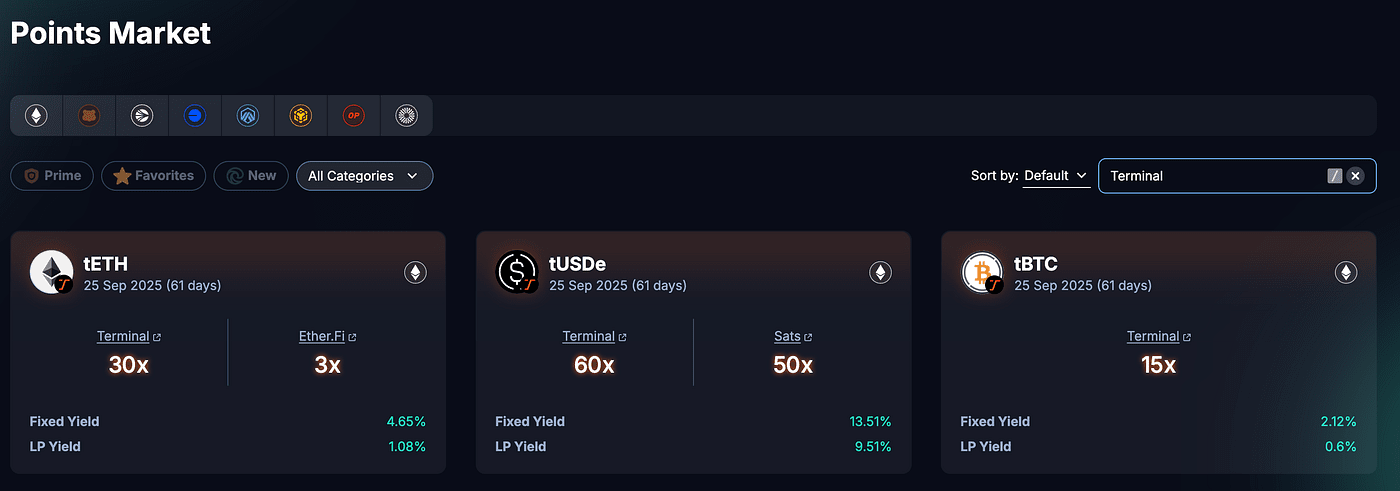
(3) PT (Principal Token) = discounted purchase of chicken farm ownership
For investors, PT is equivalent to purchasing ownership of the chicken farm at a discounted price.
So buying PT in Pendle is essentially about how to receive 'rental income' — by acquiring PT at a certain discount, which gradually disappears as the maturity date approaches, until it is fully redeemed at 1:1 at maturity. This is equivalent to purchasing future ownership of the chicken farm at a discounted price, and this discount represents PT's fixed income.
For chicken farm owners:
You have rented out the eggs (the right to income)
Only retain ownership of the chicken farm, and reclaim it after the contract ends.
You list PT, and after maturity, you can reclaim the entire chicken farm 1:1, but the eggs produced during the income period belong to others.
This gameplay is suitable for those seeking stability and wanting to lock in fixed income.
Summary: PT is 'discounted purchase of chicken farm ownership' — reclaiming principal and rental income, suitable for those who do not take eggs and seek stable returns while locking in fixed income.
In the image below, PT tUSDe is the split principal token, where users invest all funds into PT, and at maturity, they can receive a 13.51% annual yield without points.
Related link: https://app.pendle.finance/trade/points/0x07b1711d4af74af661dde3b774741993b79fc59c?chain=ethereum&search=Terminal

PT is very suitable for cyclical income; this method will be highlighted in the next section.
(4) YT (Yield Token) = the right to the earnings of the eggs
YT is the most fun, highest risk, and highest yield area in Pendle. For those who play it well, you do not need to rely on airdrop income; you can earn a lot just by trading price fluctuations, so I will elaborate more on this. I will introduce it again in my DeFi practical operations later.
Switch roles and imagine the crowd speculating on YT; YT is the 'yield rights' you rent from others:
You pay a rental fee (the cost of buying YT)
During the yield period, all the eggs produced by the chicken farm belong to you.
If the chickens lay a lot of eggs, you make a lot of profit; if the eggs are too few and you can't earn rent, you lose money.
YT carries no liquidation risk but is inherently a 'high-risk high-reward' tool.
Summary: YT 'egg income rights' → earn yield, losses are self-borne. Suitable for aggressive players, chasing airdrops, and seeking high APY.
The image below illustrates Terminal's YT gameplay, with floating yield rates and floating leverage.

(1) Why can 200 USD be exchanged for 9,282.52 YT?
This is the combined effect of the leverage principle + market pricing mechanism.
This indicates that the current unit price of YT is approximately $0.0215; when clicking Buy YT market order, 200 dollars shows 9,282.52 YT (about 46.41 times).
(2) So, the question arises, why is YT priced at $0.0215?
YT prices are not fixed; the K-line chart in the image reflects the fluctuations in YT price (indicated by yield rates).
Because YT = the right to future income for a certain period, and:
This yield is unknown: if the interest rate is low and there are no points, YT may be worthless.
YT will go to zero at maturity (it becomes invalid at maturity)
So YT is essentially about: 'buying the possibility of future returns', but this future could be 0 or a lot.
This is why the market prices YT at a very low position, such as $0.02.
(3) The principle of YT's 'implied leverage'
Earlier, I mentioned a leverage of approximately 46.41 times (not fixed), here is the principle of YT's 'implied leverage'.
You are essentially betting with $200:
Before maturity, these YT can help you earn over $200 in 'interest + points'.
If successful:
9,282 YT before maturity brings $500 in income, so you earned $300 (ROI = 150%)
If unsuccessful:
If the yield before maturity is only $100, you lose $100.
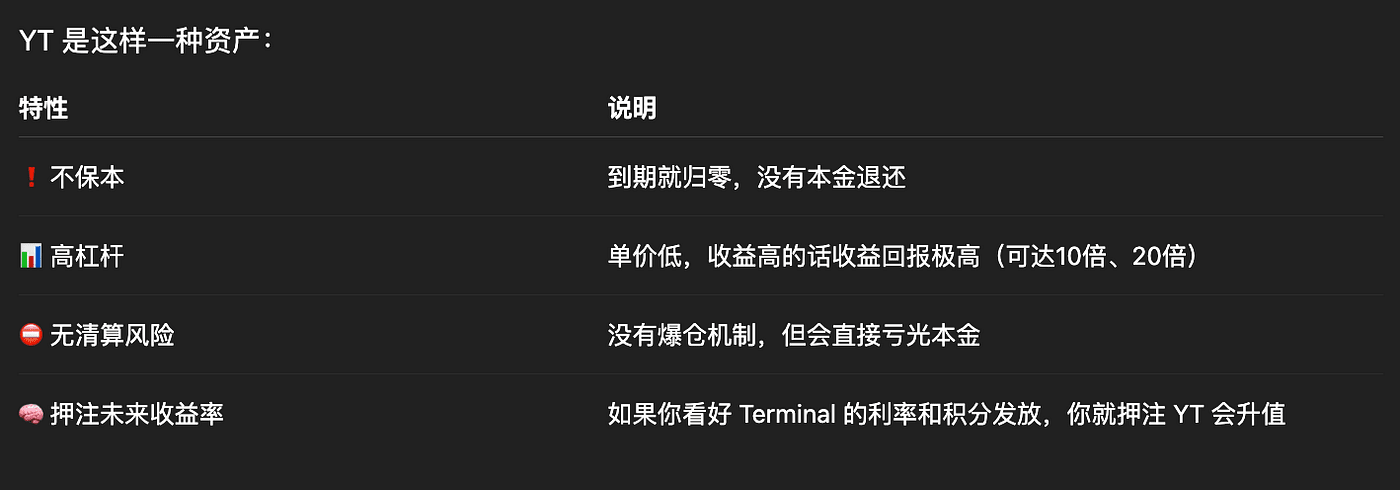
YT simplified example
Imagine using $200 to buy 9,282 scratch cards — whether each card wins depends on the yield strength of Terminal.
If the project issues a lot of points and offers high interest rates, the value of your YT will increase.
If the interest rates and points are not favorable, these YT may only be worth dozens of dollars, or even go to zero.
(5) LP (Liquidity Provider) = chicken farm + property packaged for business
LP is where you provide both SY and PT to Pendle's trading pool for:
Provide liquidity to the market
Automatically earn transaction fees, rewards, and fixed income
You are essentially packaging the 'chicken farm asset' and 'property portion' and handing it over, while Pendle uses them for trading matching, allowing you to earn 'business dividends'.
Pendle LP = a dynamic combination of SY/PT. Since SY represents the original yield-bearing asset itself, and PT is also highly correlated with the original yield-bearing asset and guarantees a 1:1 redemption of principal at maturity, holding LP until maturity also ensures at least the principal is preserved in terms of currency, without impermanent loss.
The image below illustrates Terminal's LP gameplay:
Note that there is a mode called 'Keep YT Mode', which is off by default; the principles of turning it on and off are different.
Not opening 'Keep YT Mode', when storing SY in LP, the system splits part of SY into PT and YT to generate the PT needed to form LP. Therefore, if 'Keep YT Mode' is not open, the excess YT will be sold in the AMM, and the funds obtained will also be returned to the LP.
In other words, by not opening 'Keep YT Mode', the YT generated during the LP formation process is not retained and is sold in the market, with the funds from the sale used to form more LP units. This is suitable for those slightly bearish on 'egg' yield or who do not want to hold YT, focusing on LP returns, aiming for a 'pure holding' approach to LP without wanting to manage YT.
Enabling Keep YT Mode = retaining YT mode, which is the opposite of the above process. This mode retains the YT generated during the LP formation process in hand. You ultimately receive both LP and YT as two independent parts, which can be independently exited in the future, suitable for players optimistic about future returns who want to hold YT to earn points or interest, seeking a combined strategy of 'LP + separately holding YT'.
LP participation link: https://app.pendle.finance/trade/pools/0x07b1711d4af74af661dde3b774741993b79fc59c/zap/in?chain=ethereum&view=chart

(6) Summary of PT, YT, LP
We have spent considerable space discussing the principles of Pendle-Terminal, thinking that many crypto enthusiasts might have a lot of novice fans, and many might rush in upon seeing YT's high points and yields or LP's multiple yields, so here is a more detailed popularization.
When we perform practical operations with PT, YT, and LP, we still need to pay attention to a few points:
PT can be redeemed 1:1 for the value of eETH, tUSDe, tBTC in Pendle-Terminal upon maturity;
Exiting LP before maturity does not guarantee principal preservation;
YT is a bit more complex, has higher volatility, and requires deeper understanding. Since YT represents the 'egg rights' of the chicken farm before maturity, the less time left, the fewer eggs you might obtain. Therefore, the value of YT will decrease as time passes until it goes to zero at maturity.
In short:
Beginners and conservative investors: choose PT for steady wins;
Chase airdrops, bet on a rising bull market interest rate: choose YT for high returns;
Neutral portfolio, long-term strategy: act as LP to enjoy multiple yields and reduce timing anxiety.

3. How to maximize returns from Terminal
If you are an experienced investor with a lot of idle funds, aiming for over 20% annual return in 2 months, then these strategies from community experts can serve as a reference, such as:
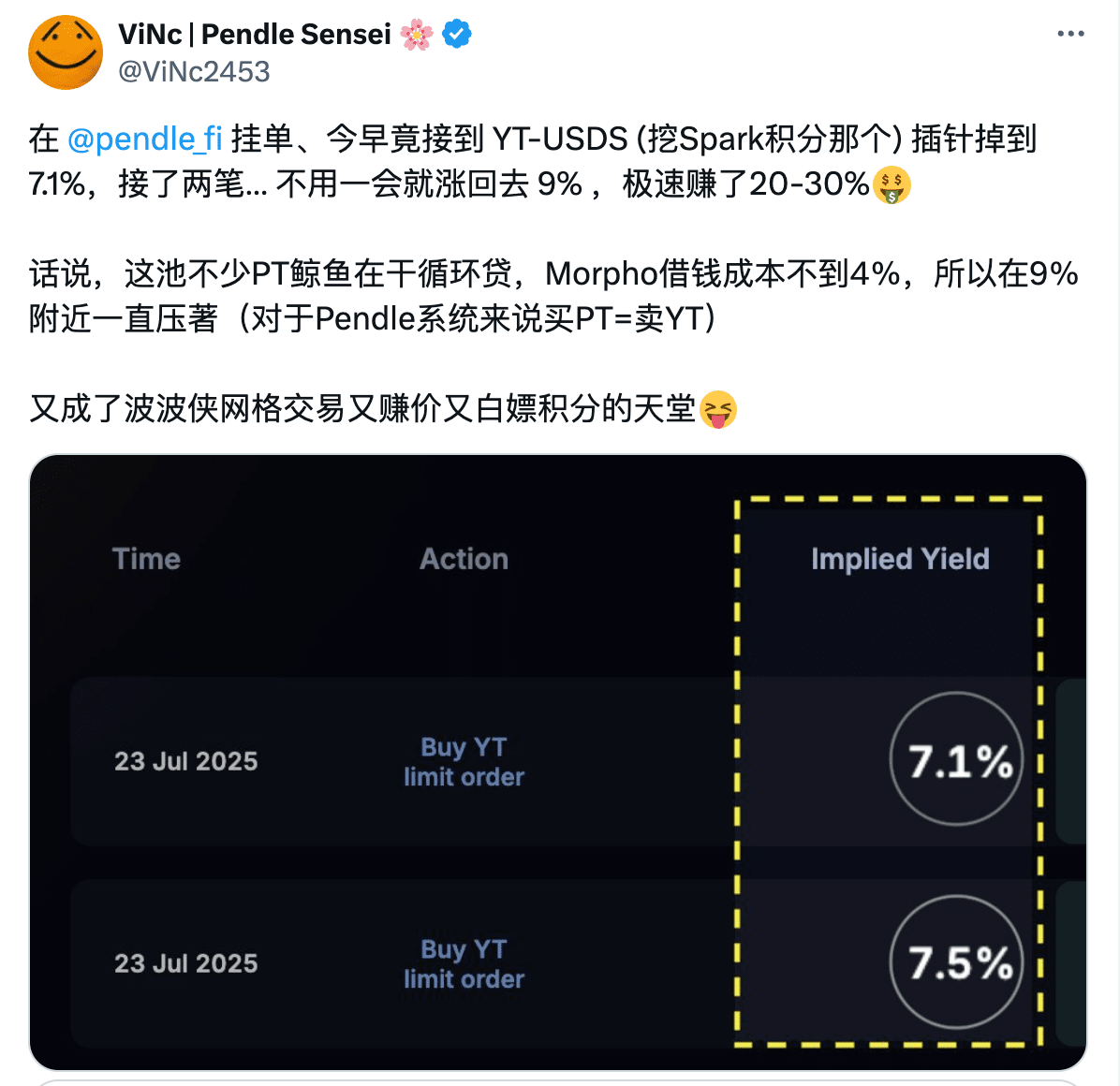
Source: https://x.com/ViNc2453/status/1948208766211797320
Here are two signals: one is for PT strategies and the other is for YT strategies, we will analyze them separately:
(1) Maximizing Terminal PT returns
The ambassador mentioned Spark; for projects that have been online for a long time, the opportunities are not as great as for new projects, so we choose Terminal for case analysis.
The idea is as follows (I will use 200 USD as an example):
Step 1: Purchase PT on Pendle-Terminal, generating PT tUSDe with a fixed annual yield of 13.58%;
Step 2: Go to the Termmax platform to pledge PT tUSDe and borrow USDC, with a borrowing rate of 10.74%;
Step 3: Return to Pendle-Terminal and use the borrowed USDC to purchase PT (can use another account);
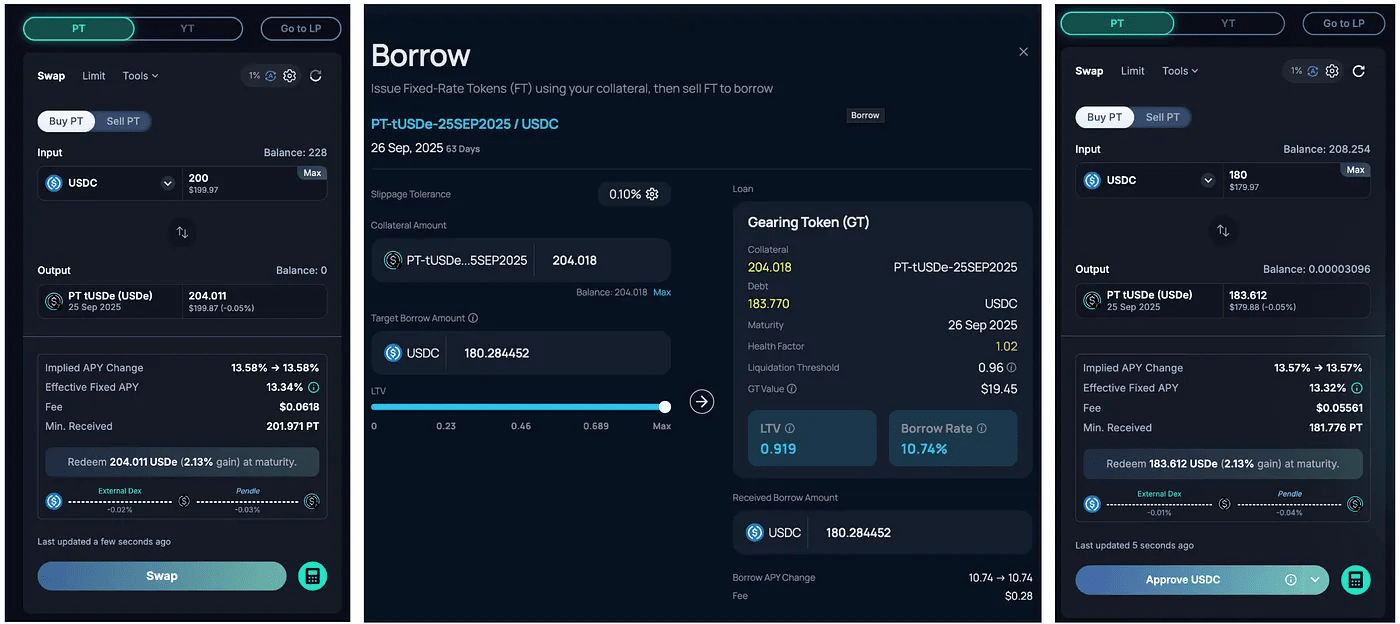
Use the above method to cycle through lending (multiple times) to earn interest differentials.
(2) Maximizing YT returns in Terminal
According to the ambassador, when YT is being injected, buy low-interest YT, and sell when YT rises to earn the interest differential.
The logic is quite simple; if many people buy PT, it means the system will sell YT, which will cause the price of YT to drop. Therefore, when the pool is first opened, YT and PT will balance, but as conservative players flood in to buy PT, YT will sharply decline. This can also be seen from the curve graph:
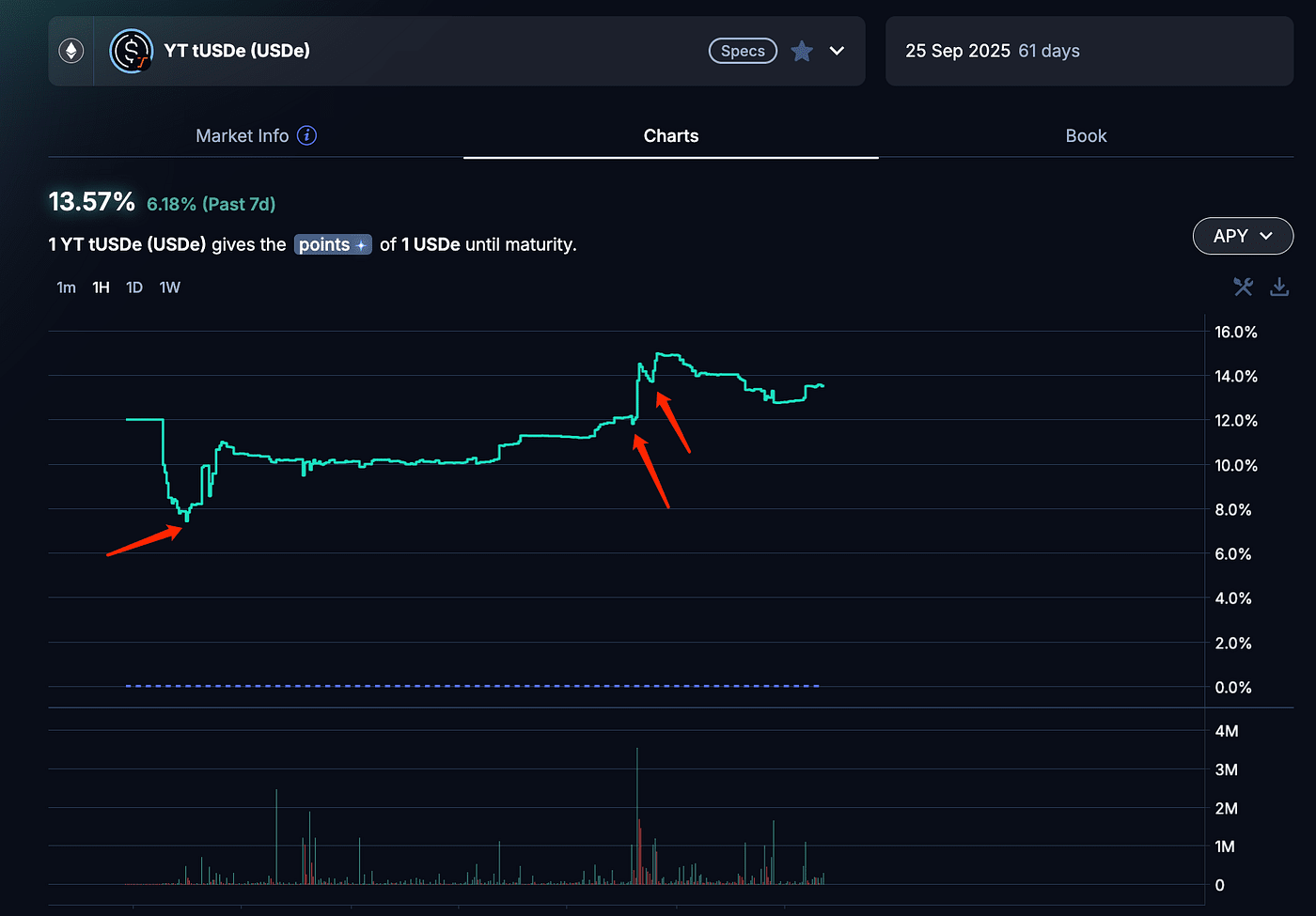
The principle is this universal formula: 1 tUSDe = 1 PT + 1 YT
Assuming you buy 1 PT in the Pendle market, then:
The system must 'unpack' it from 1 SY to let you obtain this PT;
The other YT (corresponding to the 'future income') that is unpacked must also enter the market;
In other words: the system automatically 'sells' the corresponding YT.
Therefore:
When you 'buy PT', the system is essentially 'selling YT' to you (equivalent to being the market counterparty)
In other words:
Buying PT = giving up future returns, only requiring principal → shorting future returns (YT)
Buying YT = giving up stable returns on principal, betting on future income explosions → shorting the stable annual return of PT
You will see in Pendle:
When YT is very popular (everyone bets on high future returns), YT price rises ⇒ PT discount is larger ⇒ fixed yield APY is higher;
When no one wants YT (bearish on returns), YT price drops ⇒ PT discount is smaller ⇒ fixed yield APY decreases;
Thus, the Pendle market is an interest rate gaming market, where the buying and selling of YT and PT allow users with different risk preferences to engage in price games and liquidity matching.
In summary, are you speculating on returns? Or locking in fixed returns?
Want to speculate on interest rates, earn points, and bet on airdrop surges ⇒ Buy YT (long)
Want stable annual returns, afraid of volatility ⇒ Buy PT (short)
4. Why Terminal is considered a high-potential project (technical analysis)
So far, everyone has grasped the techniques for participating in Pendle-Terminal. Now back to the initial question: with so many DeFi projects and RWA projects, why should I choose Terminal?
(1) First, understand the background of Terminal
Terminal is a DeFi yield trading market focusing on 'compliance, yield, and institutional participation', serving as a bridge between TradFi (traditional finance) and DeFi, specifically designed for RWA, stablecoin yields, and institutional arbitrage.
Over the past year, using Ethena's sUSDe and USDe as the core, it attracted a large amount of institutional capital by leveraging these assets with a 583% annual growth rate, and gained backing from Securitize (a registered RWA compliance platform in the US that issued BlackRock's $BUIDL, a leader in RWA compliance).
The previous low-profile approach was due to regulatory reasons. With the passage of the (General Digital Asset Innovation and Security Act) by the US Congress, the restrictions on DeFi brokerage rules have been lifted, allowing KYC-compliant tokenized asset trading, releasing institutional capital into the market.
Registered institutions like Securitize, which meet the KYC/KYB requirements of the Genis Act, have been approved to issue tokenized funds (like $BUIDL), with a clear compliance path. The institutional pool in Q1 2026 will directly benefit from compliance needs.
If compliance issues are resolved, institutions can enter the market on a large scale, but the platform they choose to enter is also a pain point, as there are many platforms providing solutions for institutions; why choose yours?
So this leads us to discuss Terminal's solutions.
(2) Terminal Solutions
Traditional DeFi still has various unresolved pain points:
Slippage is too high, liquidity is poor — large transactions are prone to severe slippage, making it difficult for institutions to enter;
Yield assets are difficult to trade — yield-bearing assets in AMM have a complex structure, leading to price drift and loss;
Capital efficiency is low — assets like sUSDe have long redemption cycles, affecting the flexible use of capital;
Lack of interest rate trading market — DeFi cannot conduct interest rate speculation, arbitrage, or hedging operations;
Compliance and RWA access difficulties — traditional DeFi does not support KYB, real assets, and institutional participation.
This pain point is intuitively reflected in that Ethena's sUSDe experiences permanent unavoidable loss (impermanent loss) in traditional AMM due to unilateral yield accumulation (like funding rates). This lowers the returns for liquidity providers (LP) and hinders institutional participation.
Thus, Securitize and Ethena have been quietly working on developing Converge Chain — a chain designed for 'institutions, RWA, and yield trading', entirely compliance-oriented and designed around institutional needs.
Converge provides a compliance framework, KYC/AML modules, and RWA support modules, suitable for institutions to operate, arbitrage, and invest on.
Terminal is the native DEX deployed on Converge, similar to Uniswap on Ethereum. Terminal successfully solves traditional AMM issues like slippage, impermanent loss, compliance, liquidity bottlenecks, insufficient incentives, and fragmentation through no slippage design, yield scraping, KYC compliance, RWA liquidity support, dynamic bonuses, and cross-chain integration. These innovations make it a bridge between TradFi and DeFi, occupying a leading position in institutional-level yield trading.
(3) The status of Terminal
From the above description, the Converge Chain is backed by Securitize + Ethena + Terminal;
It should be noted: there are no tokens on the Converge Chain; Terminal's $TML is the first native token of Converge and has strong potential.
Terminal is the only native DEX of Converge, and will become the trading hub for all tokenized funds and RWA products;
All TradFi projects (like tokenized T-bills) need to find secondary market liquidity on Terminal.
Thus, saying that Terminal is a bridge between TradFi (traditional finance) and DeFi is no exaggeration; it is a trading platform specifically designed for real-world assets (RWA), stablecoin yields, and institutional arbitrage. I believe this is also a key reason why its TVL skyrocketed from $0 to $140M in just two weeks.
Here, the importance, potential, and gameplay of Terminal have been mostly introduced; everyone can decide on investment based on their actual situation.
To obtain real-time information, it is recommended for everyone to join the official Pendle Telegram group: https://t.me/PendleFinance_CN
That's all for today.
Each project can operate multiple accounts. Currently, the multi-account tool I use is MorLogin fingerprint browser, which I've used for nearly a year, and its security is reliable.
You can use the cloud phone feature, and new users can register using the link below:
New users can create 50 environments for free
Use discount code: jiamigou for (20% off)
https://www.morelogin.com/?from=AANvwSB8onX4

